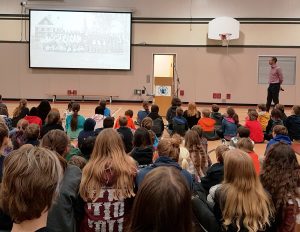Orange Shirt Day at BICS
October 21, 2018 - 5 minutes readWhat does meaningfully recognizing Orange Shirt Day look like in an Elementary School?
Our BICS Indigenous Education Committee, consisting of teachers and parents/guardians, has been considering that question since our school dipped our toe in the water in 2016 by recognizing Orange Shirt Day via a brief email to parents and as part of a September assembly. Those efforts did little more than to simply recognize the existence of Orange Shirt Day. With a K-7 student population, which in October means 4 year-olds to 12 year-olds, recognizing Orange Shirt Day in a meaningful way is not simple.
Our Committee recognized that with significant differences in developmental readiness, much of the learning should happen in classrooms so the Committee offered teachers a menu of learning related to Indian Residential Schools and supportive, authentic Indigenous resources.
But school-wide learning was also needed. Events and learning that happens school-wide are often identified by students and families as being important and we wanted students to know that recognizing Orange Shirt Day, and learning about Indian Residential Schools in Canada, was important. So, we held an intermediate assembly on Monday, October 15, and a school-wide assembly on Wednesday, October 17. On Monday, we shared the story of Phyllis Webstad, the founder of Orange Shirt Day, noting the inspiring motto of the day, “Every Child Matters” and unpacking the phrase. Grade 4-5 students also shared some of their learning from their classrooms about how the Indian Residential School system contrasted so sharply with the United Nations Convention on the Rights of the Child.
of Phyllis Webstad, the founder of Orange Shirt Day, noting the inspiring motto of the day, “Every Child Matters” and unpacking the phrase. Grade 4-5 students also shared some of their learning from their classrooms about how the Indian Residential School system contrasted so sharply with the United Nations Convention on the Rights of the Child.
On Wednesday, students and staff wore paper orange paper cut-out shirts which had the message, “I will __________, because Every Child Matters.” The point was to impress upon students that we have a collective responsibility for making the statement Every Child Matters true. During our school-wide assembly, we also celebrated a little bit of the Squamish culture with Squamish elder Sahplek, Bob Baker, who shared several songs with us, including “Esḵéḵxw ta sp’áḵwus,” “The Gathering of Eagles,” which students have been learning to sing along with over the last year. It was a great opportunity for students to further develop a personal relationship with Sahplek and the Squamish Nation and to gain a greater appreciation for aspects of Squamish culture and storytelling. Grade 7 students glued the 370 orange shirt cut-outs onto a piece of paper to preserve their “I will” statements beyond Orange Shirt Day. They are presently displayed on a bulletin board outside of the office.
In addition to our efforts with students in school, our committee decided that parent education and community education would be essential as conversations about reconciliation are important family conversations. On October 13, we offered a free screening of the film Indian Horse for the community and several members of our committee shared with attendees a list of authentic indigenous resources related to Indian Residential Schools in Canada that parents and community members could use to further their learning and stimulate conversations. To draw community members to the film, a member of our committee wrote an article for The Undercurrent explaining the significance of the film. Sahplek welcomed attendees to the screening and shared the important message that Indian Horse tells just one story among far too many. Sahplek spoke a little bit about his experiences in residential school as well. Following the film, Sahplek told the audience that while it is important that viewers attempt to contemplate the tragedy and loss of residential schools, it is also important to move forward together positively, and so, he led attendees in a song together. It was a powerful conclusion to the evening.
Indigenous worldviews and learning are embedded throughout the curriculum but Orange Shirt Day – and Orange Shirt Week as we referred to it – provides a specific opportunity for educators, students and families to make evident a commitment to rooting out discriminatory beliefs and actions that were the rotten core of the Residential School System. For our youngest learners, it is an opportunity to reinforce the point that they matter and that they have a responsibility to their peers to ensure their peers feel like they matter too.
I am grateful to our Indigenous Education Committee for their important work. Thank you Andrea, Beverley, Carmen, Cindy, Fraser, Jane, Katie, Laura, Meribeth, Sarah, Sarah, Simon, and Stephanie.
0 Comments